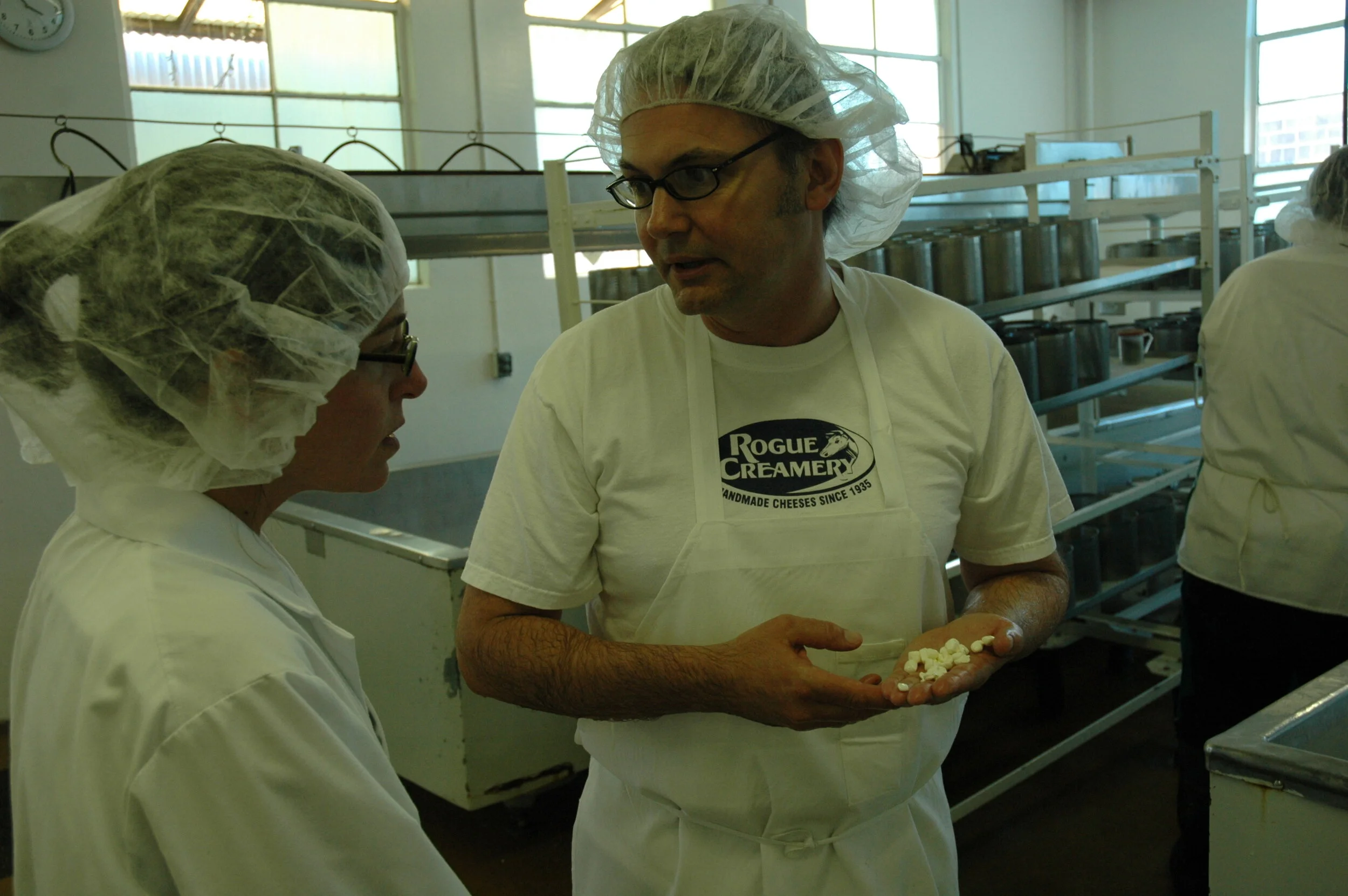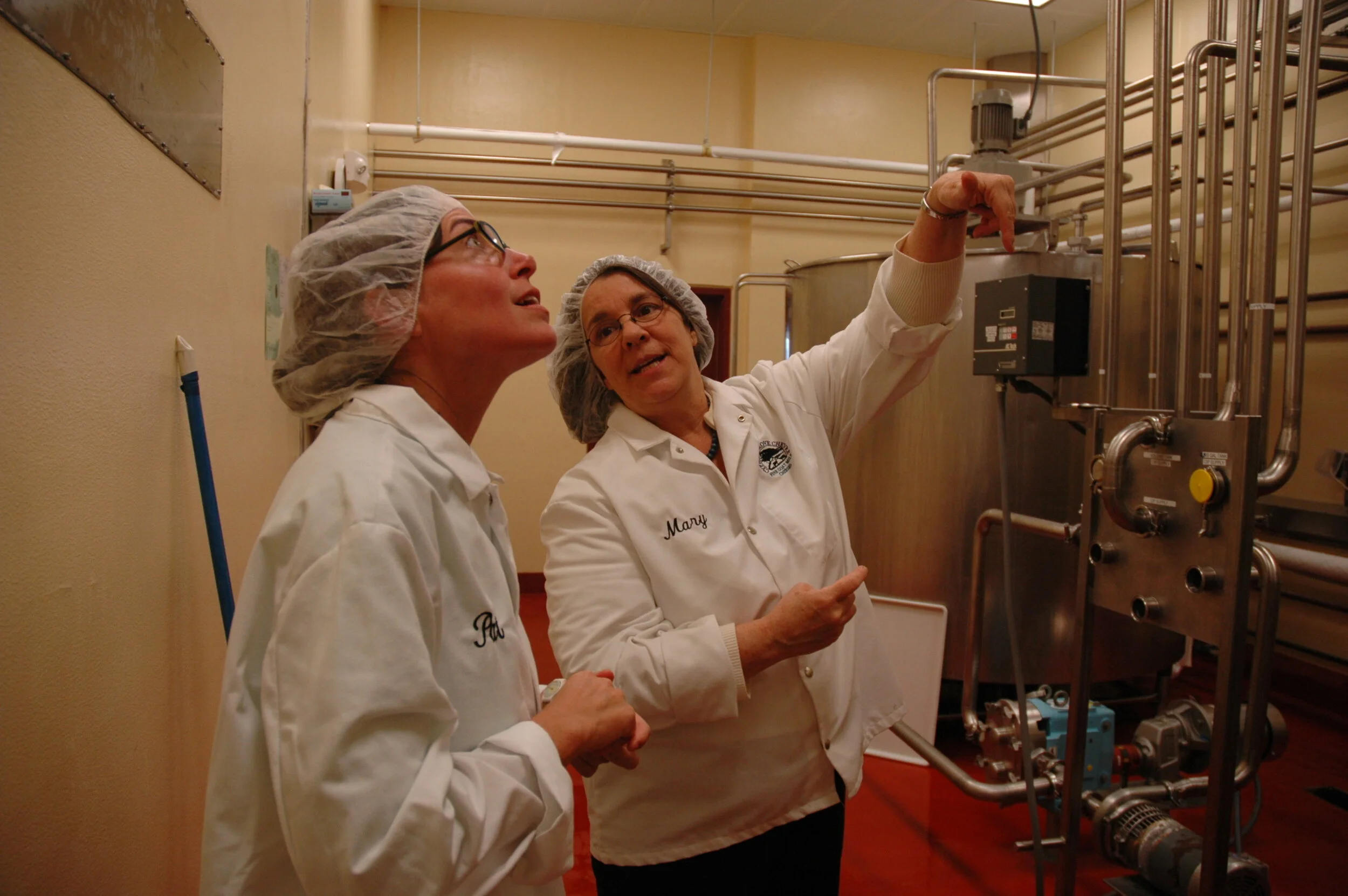Rogue Creamery: Oregon
August 2006
Name: Rogue Creamery
Owners: Carey Bryant and David Gremmels
Location: Central Point, OR
Animals: Rogue gets all of its cows’ milk from one dairy along the Rogue River. The dairy milks 200 cows and has a herd of Holsteins with a few Brown Swiss.
Cheese/Products: Crater Lake Blue, Smokey Blue, Oregon Blue Vein, Oregonzola, Rogue River Blue, Cheddar (regular and flavored), Cheese Curds
The first order of business when we arrived at Rogue was an in-depth tour with David. Before he caught wind of our presence we perused the creamery’s retail store where they have a combination of local and Italian cheeses, wines, and food stores. The Italian bit catches you off guard until you hear about the history of this place and the celebration of Italian heritage that has been part of the creamery since 1935.
David and Carey tell the history on their website, but for our purposes, it is important that you understand that Tom Vella started the place back in 1935, handed it over to his son Ignacio Vella who sold it to David and Carey four years ago with the stipulation that they would continue to make the creamery’s signature cheeses according to tradition. Another part of this agreement is that Ig spends a week out of each month at the creamery observing and providing guidance and expertise to their cheesemakers.
All of the offices are in the old house where the Vellas lived, there is another building across the road that serves as housing for the production manager and as a place to stay for Ig when he visits the creamery. David took us over to the blue cheese making room which is in a separate building from the cheddar making and retail shop. There were four guys working on pulling curd from the vat- timing is critical as the curd continues to acidify when it sits in the whey. Eight forms are set on a metal shelf that straddles the vat, the curd is scooped up and spread amongst these forms until they are full and then the cheesemaker slides a metal disc under each form one by one so they can be moved onto the large retail racks for draining. The racks are all at a slant to promote draining- this also means the cheeses must be flipped at regular intervals for the first 24 hours to level out the wheels (otherwise they would be slanted on one side).
We walked into the blue cheese cave which was absolutely teeming with racks of blue wheels- some pierced, some coated in melting salt crystals- and the aroma was to die for...sweet cream with a hint of blue mold. All wheels are dry salted for the first 7 days after they are made. On day eight the wheels are perforated to activate the aerobic blue molds that require oxygen to bloom (they actually test each batch to ensure it is ready for piercing). We got to see Poasa (who is also training to make cheese) doing perforations and waxing. From this point on, the wheels are all set on their sides and turned one quarter turn each day. The salting of newer batches and rotating of aging batches is no small task- even though you are in a delicious smelling room. After (60-75) days the wheels are waxed and moved to cold storage for long term aging. Although it took some convincing, David got us out of the cave and into the packaging room to meet Anna- the team leader- and see the immense amount of work that goes into packaging each wheel- all by hand of course. The wax is broken off and any stray bits of wax that crept into the perforations are plucked out before the wheels are wrapped in foil and sealed in plastic.
The following morning we watched the earlier stages of cheesemaking- Rogue has the oldest pasteurizer in the western U.S. which was designed by Tom Vella and although they do not pasteurize the milk they use for their blue cheese making they do use this piece of equipment to get the milk up to cheesemaking temperature. We got to see their new cheese harps in action before we took a break to interview David (Carey was at Oregon State working with a graduate student to define their raw and pasteurized milk study). It is clear that at Rogue there are three main priorities: preserving tradition, creating an excellent working environment (they have a better benefits package than many larger companies), and providing high quality cheese.
A number of the employees at Rogue are lifelong residents of Central Point who remember coming to the creamery as kids for curds and they have re-discovered it as a place to learn new ways to apply their expertise from previous careers. A couple examples of this are Craig and Mike- two of their cheesemakers. Craig came to Rogue with decades of experience in military management and has taken on some production manager responsibilities while learning to make cheese. When Mike started at the creamery his expertise in refrigeration came in handy and over time, he has discovered that he is very interested in the science of cheese and Carey is now training him to take over their internal lab work.
When we left the creamery we drove over to the Rogue River to meet Delmar at Rogueview Dairy- the source for the milk used for their cheeses. He has 70 acres with 1/4 mile frontage on the river- a beautiful piece of property in a valley that used to be loaded with small dairies of 15-20 cows. Delmer started with 90 cows and has grown to 200 where he has held for the past 15 years. The milkers go out on pasture daily when weather permits (which is from March-October) but are not exclusively grass-fed, they also get hay and grain. The dairy is now surrounded by homes, the same suburban encroachment that we’ve seen across the country- and although he hasn’t had many complaints from neighbors, those homes are a constant reminder of the value he could get for his land should he decide to sell it for development.
Our visit with Delmar is a reminder of the tenuous nature of relationships between dairies and creameries all over the U.S. as the temptation to sell out and stop working so hard is great for dairy farmers. Given the current situation we are particularly thankful for creameries like Rogue who are committed to sourcing locally and working with dairies like Rogueview to restore the economic viability of dairy farming.








